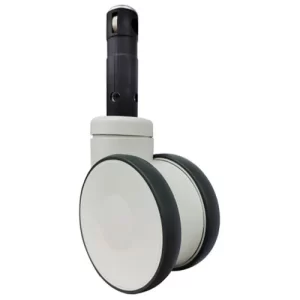Hospital Bed Wheels 5 Inch 125mm Hospital Caster Wheel Central Locking System Polyurethane Tread for Patient Bed and Medical Stretcher
Wheel Material:PU,PA,ABS
Size:5?? x 61mm ; 6?? x 70mm
Loading Height:149mm ; 175mm
Dynamic Loading Capacity:125kg-150kg
Static Loading: 250kg ~300kg
Lock:Central Locking
Bearing Type:Precision Mute Bearing
Central Locking Optional: ?32mm x 50mm , ?28mm x 98.5mm
Widely used as hospital bed caster,Medical trolley caster, stretcher caster,Laboratory Casters,health care bed casters,UNIVERSAL TABLES caster,Bariatric caster
| Caster?No. | Wheel | Material | Bearing | Height | Lock?Stem | Loading |
| CLCPULR-5 | 125x?61 | PU | Ball?Bearing | 149 | ?28?x?98.5 | 125?kg |
| CLCPULR-6 | 150?x?70 | PU | Ball?Bearing | 175 | ?28?x?98.5 | 150?kg |
Huanxin offers medical-grade casters for a variety of uses, including hospital bed casters, medical cart casters, casters for IV poles and ventilators, and other medical equipment casters.
Regardless of the application, helping to provide safety and a pleasant patient experience is of utmost importance. To ensure the best environment is provided for healing patients, hospitals are graded by patients via HCAHPS survey scores. HCAHPS (the Hospital Consumer Assessment of Healthcare Providers and Systems) is a patient satisfaction survey, enforced by the Centers for Medicare and Medicaid Services, for hospitals in the United States. In order to ensure that casters do not detract from patients?? experience in a hospital, medical casters need to be extremely smooth and quiet.
Check out our Medical Cart Casters To Eliminate Noise guide to help you get started in your search for quiet casters – it’s great for medical and non-medical industry searchers alike.
Below, you??ll find all of our medical casters that meet our high standards for this industry. Contact us if you don??t see what you need or if you would like some guidance in purchasing medical casters.
Due to the nature of the medical industry, casters for medical usage require special considerations. Exposure to fluids and chemicals often require frequent wash-downs, and quiet mobility provides recovering patients with one less distraction. Stainless Steel casters and Nylon-bodied casters are rust resistant and can withstand exposure to chemicals and washdowns. Precision bearings in both swivel raceways and wheels provide a smooth, quiet ride for both cart and patient. While they may be labeled “medical,” these casters are also great for any environment where chemicals are possible, or when a quiet caster is preferred.
Huanxin medical equipment and hospital bed casters are engineered to offer versatility and provide ergonomic operation. Requiring only minimal maintenance to help ensure a long service life, these swivel casters are manufactured from high-performance materials under rigorous quality control standards.
Featuring distinctive, attractive design styles, they are ideal for hospital beds, anesthetic, diagnostic, and treatment equipment, and a wide range of associated medical and hospital furniture, electronic equipment, and appliances.
We offer a full line of casters and wheels ideal for the medical industry from top manufacturers. Medical casters and wheels are vital to healthcare, pharmaceutical and institutional industries that have unique motion control needs. Medical caster assemblies not only have to move along multiple axes, but they have to do so in a variety of environments and conditions — especially frequently washed-down areas, sterile zones, or applications subjected to corrosive elements.
Our medical line of casters are available in a variety of materials and finishes from nylon to stainless steel. These casters also come in a variety of sizes, mount types and load rating ranges to withstand diverse weight capacities. With any medical caster, it’s a high priority to reduce operator strain and provide patient comfort especially on hospital beds. Our medical casters have been used for diagnostic equipment, hospital beds, hospital carts, stretchers, IV poles and other mobile medical equipment. Additionally, our casters come in a variety of aesthetically pleasing designs to avoid looking industrial or threatening to patients. Our extensive category include multiple product lines used in the medical industry.
Our?Medical Casters?range in size from 3/4?? to 1-7/8??. You can also select your wheel size, wheel type, and caster options to fit you specific need.?Click here Medical Casters



Reviews
There are no reviews yet.